Cherie Magnus's Blog, page 4
July 23, 2012
La Tanguera's New Clothes
I wrote about "tango clothes" several years ago, and strangely enough it's still one of our most popular posts:
What Not to Wear to the Milonga.
That just shows you that this topic of dressing yourself is never out of date.
However the post itself is rather dated. Many, many students write to me before their arrival in Buenos Aires to ask where can they buy "tango dresses." So it's time I update "What to Wear to a Milonga" for the tanguera fashionistas, because it's a whole new world out there!
We women being as we are, whenever we get into a new activity we must first get the wardrobe. Proper ski clothes, yoga pants, Muy Thai shorts and jasmine garlands, flamenco nailed shoes and ruffled long skirts, there's a catalogue and and hundreds of choices available for every endeavor. God forbid we wear what we find in the back of our closet until we learn the fundamentals.
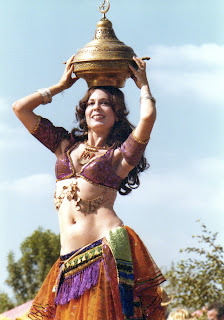 While I seem rather undressed, it took a lot of preparation to achieve it.
While I seem rather undressed, it took a lot of preparation to achieve it.
When I was belly dancing professionally, several girls in my troop admitted they were in it for the costuming opportunities. For me, I resented the time I needed to make up, as I was in it for the dancing.
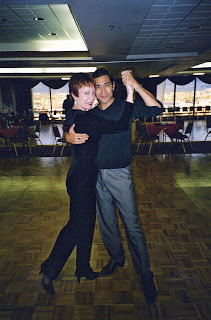 With El Indio
With El Indio
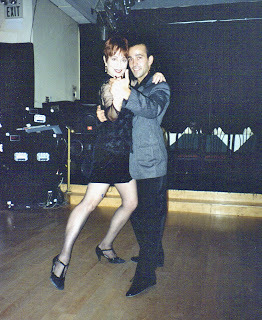 With Guillermo Merlo (skirt getting shorter)
With Guillermo Merlo (skirt getting shorter)
When I began tango lessons, I did wear regular clothes from my librarian closet.
Not that I don't understand the fun and psychology of buying lots of new stuff because your life is soon going to change with this new activity you're taking up, and we all know that the tango certainly can change your life. But I would just like to stress caution here; before we need the Comme Il Faut shoes and the "tango clothes," we need to learn to dance. A tanguera was never made (except perhaps in the movies) by wardrobe. The truth is, if you take a beginner and put her into a slinky gown by Mimi Pinzon, for example, a gown made for stage performances but which most traveling tangueras think of as a "tango dress," she's going to look ridiculous on the milonga floor--except maybe back home where she may wow the locals with her Buenos Aires threads.
 In Buenos Aires
In Buenos Aires
So here in BsAs, "tango dresses" tend to be sparkly, have fringe and/or beading, and high slits up the thigh. What real women wear to the milongas are nice dresses suitable to the season, often with a floaty or swingy skirt, and a pretty top--an outfit appropriate perhaps to going out to a nice restaurant (although here, except for dancing, one wears jeans/pants everywhere). Some women do wear pants to the milonga but it's only successful if they have perfect apple asses.
Pretty skirts and dresses are the norm, but so are gorgeous tango shoes. That is the area of importance. Often a man will look first at a woman's shoes before trying to cabeceo her; faulty shoes = a faulty dancer in most folks' minds.
Outside of Buenos Aires (and within in the very young milongas) the dress codes are different. The attitude is, "if you're young and you've got it, flaunt it" and wear as little as possible. So the new designers for tango come up with little fairy outfits held together by silken threads, baring as much as possible. These dresses are exquisite on a young dancer with a perfect body and who also dances exquisitely. If you're a beginner but look great in the outfit, wear it with a coverup to a wedding and save it until your dancing reaches the same level before you try it out at a milonga. Believe me, wearing the kit without the technique to back it up, makes you look a whole lot worse.
One design aspect that has always been important is that your outfit has back interest. When your chest is pressed up against your partner, the only thing essential about the front of your bodice is that there is no pin or bulky buttons or corsage sticking into either one of you.
Now more than ever, people are wearing skirts that accentuate the derriere of the dancer while the upper back is almost completely bare. This can look great, but many of the milongueros are uncomfortable embracing a woman with a totally bare back. In the old days, they carried a folded handkerchief in their palms to avoid sweating on the lady's skin.
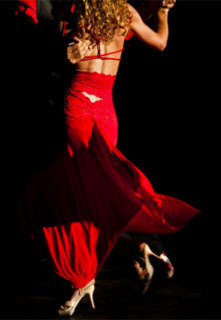 TangoLace
TangoLace
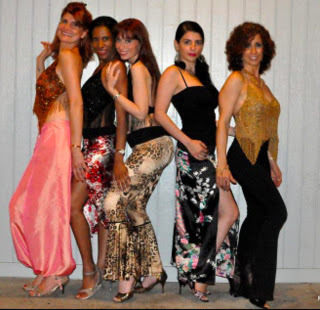 Suerte Loca Tango Clothes by Becka (at far left)
Suerte Loca Tango Clothes by Becka (at far left)
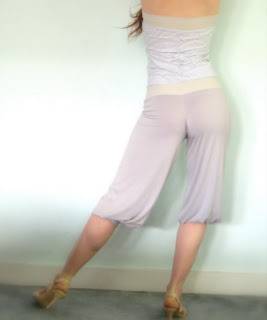 Poema Line by Hannah Louise
Poema Line by Hannah Louise
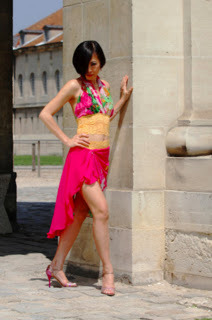 Two To Tango by Mytienne
Two To Tango by Mytienne
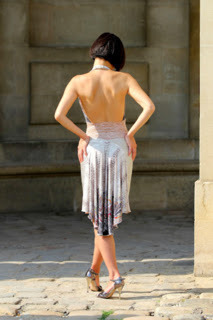 Two To Tango
Two To Tango
Please take a look at the photos in my previous post on What Not to Wear. Not only do we want our clothing to be "dance-proof," which means we can raise our arms up comfortably without causing havoc at our waistlines or hemlines, but we don't want to look like "mutton dressed as lamb" or worse, tarts.
And for you guys out there, please leave your Carlos Gardel drag at home; no fedoras, no white scarves, and, sorry, unless you're dancing canyengue or swing, no black and white shoes. We can't even talk about red, blue, or golden glitter shoes so close to dinnertime.
Elegance is the goal--in our appearance and in our dancing.

That just shows you that this topic of dressing yourself is never out of date.
However the post itself is rather dated. Many, many students write to me before their arrival in Buenos Aires to ask where can they buy "tango dresses." So it's time I update "What to Wear to a Milonga" for the tanguera fashionistas, because it's a whole new world out there!
We women being as we are, whenever we get into a new activity we must first get the wardrobe. Proper ski clothes, yoga pants, Muy Thai shorts and jasmine garlands, flamenco nailed shoes and ruffled long skirts, there's a catalogue and and hundreds of choices available for every endeavor. God forbid we wear what we find in the back of our closet until we learn the fundamentals.
 While I seem rather undressed, it took a lot of preparation to achieve it.
While I seem rather undressed, it took a lot of preparation to achieve it.When I was belly dancing professionally, several girls in my troop admitted they were in it for the costuming opportunities. For me, I resented the time I needed to make up, as I was in it for the dancing.
 With El Indio
With El Indio With Guillermo Merlo (skirt getting shorter)
With Guillermo Merlo (skirt getting shorter)When I began tango lessons, I did wear regular clothes from my librarian closet.
Not that I don't understand the fun and psychology of buying lots of new stuff because your life is soon going to change with this new activity you're taking up, and we all know that the tango certainly can change your life. But I would just like to stress caution here; before we need the Comme Il Faut shoes and the "tango clothes," we need to learn to dance. A tanguera was never made (except perhaps in the movies) by wardrobe. The truth is, if you take a beginner and put her into a slinky gown by Mimi Pinzon, for example, a gown made for stage performances but which most traveling tangueras think of as a "tango dress," she's going to look ridiculous on the milonga floor--except maybe back home where she may wow the locals with her Buenos Aires threads.
 In Buenos Aires
In Buenos AiresSo here in BsAs, "tango dresses" tend to be sparkly, have fringe and/or beading, and high slits up the thigh. What real women wear to the milongas are nice dresses suitable to the season, often with a floaty or swingy skirt, and a pretty top--an outfit appropriate perhaps to going out to a nice restaurant (although here, except for dancing, one wears jeans/pants everywhere). Some women do wear pants to the milonga but it's only successful if they have perfect apple asses.
Pretty skirts and dresses are the norm, but so are gorgeous tango shoes. That is the area of importance. Often a man will look first at a woman's shoes before trying to cabeceo her; faulty shoes = a faulty dancer in most folks' minds.
Outside of Buenos Aires (and within in the very young milongas) the dress codes are different. The attitude is, "if you're young and you've got it, flaunt it" and wear as little as possible. So the new designers for tango come up with little fairy outfits held together by silken threads, baring as much as possible. These dresses are exquisite on a young dancer with a perfect body and who also dances exquisitely. If you're a beginner but look great in the outfit, wear it with a coverup to a wedding and save it until your dancing reaches the same level before you try it out at a milonga. Believe me, wearing the kit without the technique to back it up, makes you look a whole lot worse.
One design aspect that has always been important is that your outfit has back interest. When your chest is pressed up against your partner, the only thing essential about the front of your bodice is that there is no pin or bulky buttons or corsage sticking into either one of you.
Now more than ever, people are wearing skirts that accentuate the derriere of the dancer while the upper back is almost completely bare. This can look great, but many of the milongueros are uncomfortable embracing a woman with a totally bare back. In the old days, they carried a folded handkerchief in their palms to avoid sweating on the lady's skin.
 TangoLace
TangoLace Suerte Loca Tango Clothes by Becka (at far left)
Suerte Loca Tango Clothes by Becka (at far left) Poema Line by Hannah Louise
Poema Line by Hannah Louise
 Two To Tango by Mytienne
Two To Tango by Mytienne Two To Tango
Two To TangoPlease take a look at the photos in my previous post on What Not to Wear. Not only do we want our clothing to be "dance-proof," which means we can raise our arms up comfortably without causing havoc at our waistlines or hemlines, but we don't want to look like "mutton dressed as lamb" or worse, tarts.
And for you guys out there, please leave your Carlos Gardel drag at home; no fedoras, no white scarves, and, sorry, unless you're dancing canyengue or swing, no black and white shoes. We can't even talk about red, blue, or golden glitter shoes so close to dinnertime.
Elegance is the goal--in our appearance and in our dancing.
Published on July 23, 2012 15:42
July 7, 2012
B.A. Tango #211 Free Download
Due to technical difficulties there was no edition of
B.A. Tango
for the last quarter. Here is the issue for July, August and September 2012, which is in three parts for higher graphic quality. Enjoy the best tango magazine of Buenos Aires!
B.A. Tango #211 Part 1
B.A. Tango #211 Part 2
B.A. Tango #211 Part 3
B.A. Tango #211 Part 1
B.A. Tango #211 Part 2
B.A. Tango #211 Part 3
Published on July 07, 2012 12:59
July 5, 2012
The Armenian "Church of Tango" in Palermo
Today is Armenian Constitution Day, and a perfect time to blog about a new milonga venue in Buenos Aires. Right across the street on calle Armenia from the historic Club Armenia where the infamous La Viruta milonga takes place, is the Armenian church hall, Sala Siranush, the elegant new home of La Milonguita on Wednesday nights. In this part of Palermo there are many Armenian culture clubs and restaurants.
My book isn't the only Church of Tango!
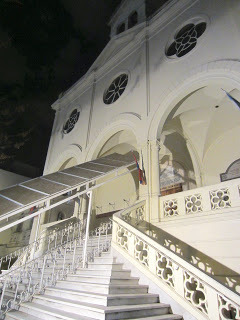
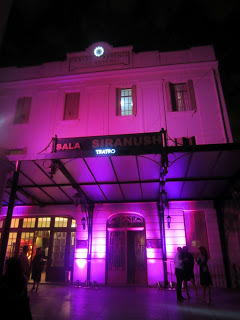
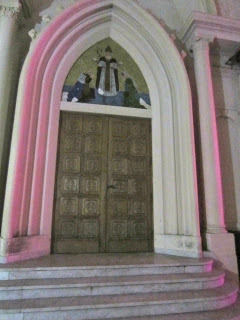
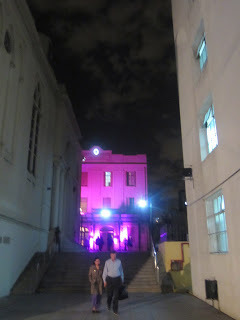
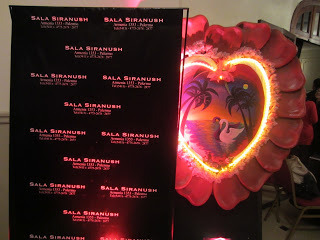
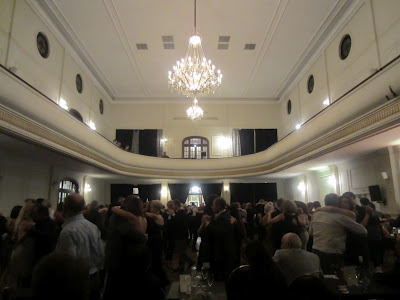 Salon Siranush
Salon Siranush
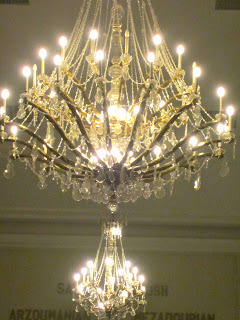
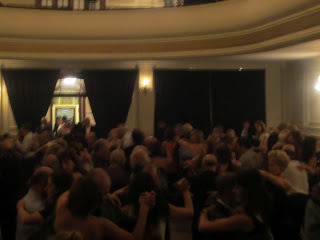
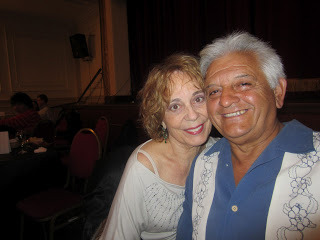
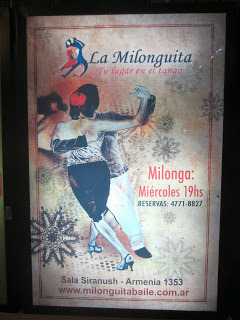
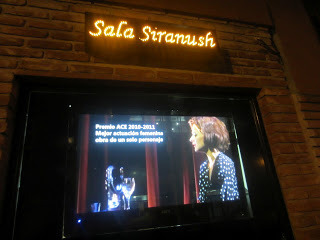
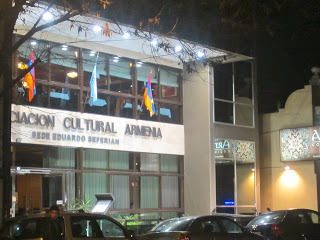 Home of La Viruta across the street
Home of La Viruta across the street
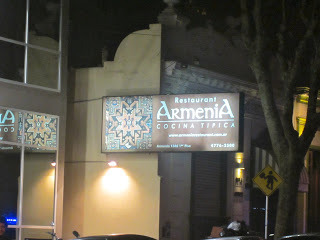

My book isn't the only Church of Tango!





 Salon Siranush
Salon Siranush




 Home of La Viruta across the street
Home of La Viruta across the street
Published on July 05, 2012 11:32
June 24, 2012
The Laws of Tango, Part II: The Music
Here is the second installment of Fernando and Daniel's informative bilingual Tango series on BACast podcasts, which you can download and subscribe to on iTunes.
It's bilingual but not translated, so if you have some Spanish listen hard to the experts speaking rapid Castellano. Less wacky and funny than Part I, there is a lot of information to be had here from pros who know what they're talking about, and they illustrate their charla with music samples. One point that hit home with me is that you can play perfectly a tango from a score, but it still isn't "tango" without a certain feeling, rhythmic emphasis that isn't written down on the sheet music.
Ruben and I enjoyed contributing to The Laws of Tango, Part I: The Dance.
Part III promises to be extremely interesting as it's about tango lyrics and philosophy. Can't wait.
(Don't give up listening because of the rather long commercial at the beginning for the Chili Cook-off on July 1st.) Just endure; it's worth it to get to the good stuff.

It's bilingual but not translated, so if you have some Spanish listen hard to the experts speaking rapid Castellano. Less wacky and funny than Part I, there is a lot of information to be had here from pros who know what they're talking about, and they illustrate their charla with music samples. One point that hit home with me is that you can play perfectly a tango from a score, but it still isn't "tango" without a certain feeling, rhythmic emphasis that isn't written down on the sheet music.
Ruben and I enjoyed contributing to The Laws of Tango, Part I: The Dance.
Part III promises to be extremely interesting as it's about tango lyrics and philosophy. Can't wait.
(Don't give up listening because of the rather long commercial at the beginning for the Chili Cook-off on July 1st.) Just endure; it's worth it to get to the good stuff.
Published on June 24, 2012 05:58
June 11, 2012
Gaucho Fair in Mataderos
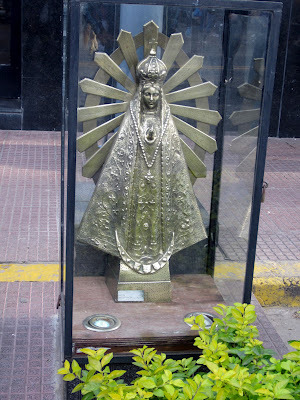 Every fair has its virgin.
Every fair has its virgin.Over the years I've often written about my favorite thing to do in Buenos Aires--after the tango: visit the Feria de Mataderos.
One of the services we provide our students is an excursion to the Fair. But yesterday Ruben and I just decided to go there alone for lunch at our favorite parrilla. A beautiful day, the fair was bustling with more visitors, more booths of arts and crafts and regional foods, more music and dancing than ever.
If you'd like to visit, check out the Fair's website for all the particulars. Just remember it's closed during the summer, and don't go if it's raining. And of course you can also take a tour there with us as your guides. Ruben is a fount of information on the gaucho history and tradition and how it relates to the tango. Just email for information: tangocherie at gmail dot com.
Meanwhile, here are some snaps of yesterday's trip. Because in previous blogs about Mataderos I concentrated more on the gauchos and their horses and the music and the dancing, this time it's about shopping for food and gifts.
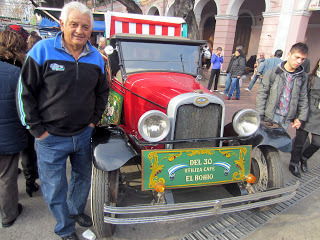 A coffee wagon
A coffee wagon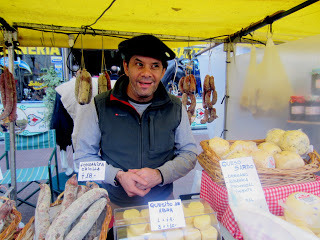 Who wouldn't buy country cheese from this guy? We did.
Who wouldn't buy country cheese from this guy? We did.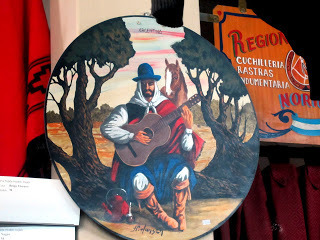 You can outfit your self completely from head to toe as a gaucho or his girlfriend, "china."
You can outfit your self completely from head to toe as a gaucho or his girlfriend, "china."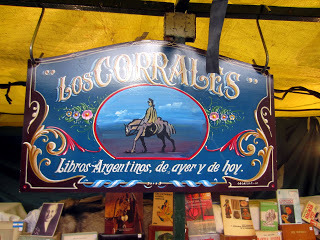 Old books for sale--did gauchos have much time for reading?
Old books for sale--did gauchos have much time for reading?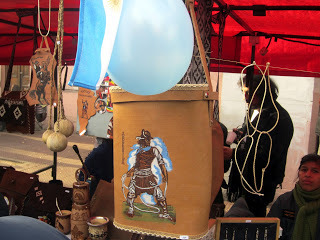 Horsey stuff one might need along with a leather mate kit
Horsey stuff one might need along with a leather mate kit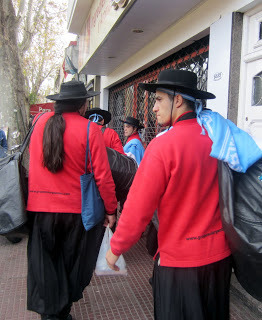 Troupe of folkdancers
Troupe of folkdancers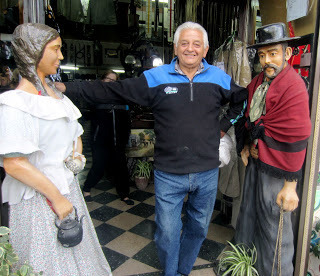 Never come because a gaucho and his china!
Never come because a gaucho and his china!
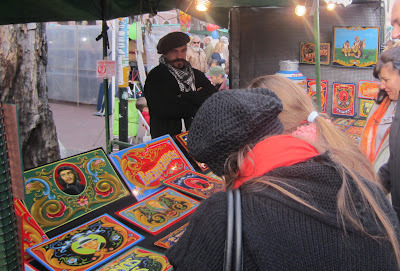 The artist standing behind his wares will happily make you a custom plaque in the distinctive porteño style of afileado.
The artist standing behind his wares will happily make you a custom plaque in the distinctive porteño style of afileado.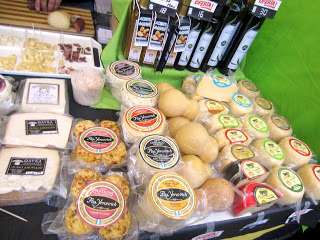 Lots of country cheeses from all over Argentina
Lots of country cheeses from all over Argentina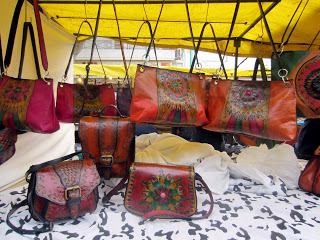 Like leather? Here's the place to get inexpensive hand made craft work
Like leather? Here's the place to get inexpensive hand made craft work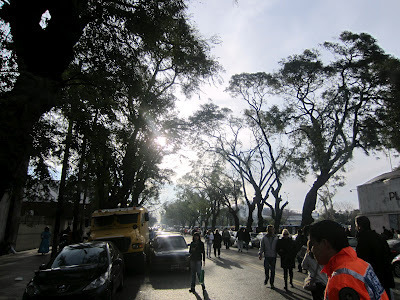 Leaving the fair after a fun afternoon
Leaving the fair after a fun afternoon
Published on June 11, 2012 13:43
June 2, 2012
The Milonguero Way Redux
This topic has come up again recently and so I thought I'd repost this from April 2010:
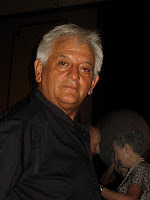
I am a "professional" dancer because I teach tango and get paid for exhibitions. But I wouldn't be a pro here in Buenos Aires if it weren't for my partner, Ruben Aybar. He is the draw. He is the Argentine who spent most of his life in the milongas, who lives and breathes and sings the tango. He is the teacher that students admire, adore and try to emulate.
Foreign dancers especially love getting to know a milonguero like Ruben and hearing his stories and dance secrets that otherwise they wouldn't be able to do, particularly if they don't speak Castellano.
Ruben wasn't always a professional dancer; he used to work in television until the crisis of 2001. He was passionate about his job, traveled all over Argentina working, and danced tango every night for the love of it.
Now tango is his job. He earns his livelihood from tango. It's now more than pleasure; it's work--which he enjoys. He teaches, does taxi dancing, and gives historical Tango Tours of Buenos Aires.
Sometimes this puts him in a difficult situation with friends at the milongas we go to for enjoyment and socializing. (We also go to milongas for work when we do milonga accompaniment.)
Foreign women friends expect that Ruben will dance with them. Sometimes he does. But if not, sometimes they outright ask him to dance , which puts him in a bad place as it does with all milongueros. For one thing, milongueros don't like to be invited, nor do they want to refuse a lady, and for another, if he danced with all the women who wanted him to, what about me? What about our social evening together? We are at Los Consagrados or Chiqué to enjoy ourselves.
The macho milongueros of Argentina do not like to be put in an awkward position they didn't choose. I've seen men refusing a woman forever because she once asked him to dance. Don't do it, ladies. If you want to invite men to dance, stay in your own countries/milongas; don't try it in the traditional Buenos Aires milongas where the cabeceo rules. The men want to decide when and with whom to dance, as well as how to embrace and lead their partner. (If a woman wants to invite, she should lead as well and there are several alternative milongas in Buenos Aires where she can.)
Ruben will always dance one tanda with current students. It's part of their education and he likes to check their progress. And he will bend over backward to make sure the friends sitting at our table get their drink orders, are comfortable, and have a great time at the milonga.
But there are friends who expect dances with Ruben at the same time they are telling me they are taking classes at DNI, or Canning, or expensive privates with Maximiliano Superstar. They ask me to "tell" Ruben to dance with them! Ruben owns his own dance. (I do not give him orders.) Read more here.
They expect him to give it away for free. They forget that the tango is what he has to sell.
Do these same people ask for free consultations from doctors and lawyers at social gatherings back home?
Ruben is a low-profile real milonguero, not a stage dancer who tours the world giving classes and making a big name for himself and who no one's ever seen at a milonga. Ruben is in Buenos Aires every week of the year dancing in the milongas, as he's done for the past 30 years. All the women want to dance with him and all of the men want to dance like him. But he is a professional. Friendly, affable, funny, and fun as well. And available for classes and milonga accompaniment.
I wish the women would remember that at the milongas.
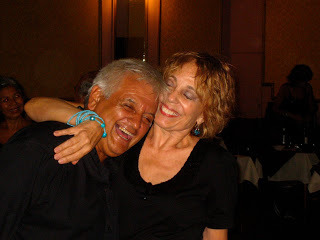


I am a "professional" dancer because I teach tango and get paid for exhibitions. But I wouldn't be a pro here in Buenos Aires if it weren't for my partner, Ruben Aybar. He is the draw. He is the Argentine who spent most of his life in the milongas, who lives and breathes and sings the tango. He is the teacher that students admire, adore and try to emulate.
Foreign dancers especially love getting to know a milonguero like Ruben and hearing his stories and dance secrets that otherwise they wouldn't be able to do, particularly if they don't speak Castellano.
Ruben wasn't always a professional dancer; he used to work in television until the crisis of 2001. He was passionate about his job, traveled all over Argentina working, and danced tango every night for the love of it.
Now tango is his job. He earns his livelihood from tango. It's now more than pleasure; it's work--which he enjoys. He teaches, does taxi dancing, and gives historical Tango Tours of Buenos Aires.
Sometimes this puts him in a difficult situation with friends at the milongas we go to for enjoyment and socializing. (We also go to milongas for work when we do milonga accompaniment.)
Foreign women friends expect that Ruben will dance with them. Sometimes he does. But if not, sometimes they outright ask him to dance , which puts him in a bad place as it does with all milongueros. For one thing, milongueros don't like to be invited, nor do they want to refuse a lady, and for another, if he danced with all the women who wanted him to, what about me? What about our social evening together? We are at Los Consagrados or Chiqué to enjoy ourselves.
The macho milongueros of Argentina do not like to be put in an awkward position they didn't choose. I've seen men refusing a woman forever because she once asked him to dance. Don't do it, ladies. If you want to invite men to dance, stay in your own countries/milongas; don't try it in the traditional Buenos Aires milongas where the cabeceo rules. The men want to decide when and with whom to dance, as well as how to embrace and lead their partner. (If a woman wants to invite, she should lead as well and there are several alternative milongas in Buenos Aires where she can.)
Ruben will always dance one tanda with current students. It's part of their education and he likes to check their progress. And he will bend over backward to make sure the friends sitting at our table get their drink orders, are comfortable, and have a great time at the milonga.
But there are friends who expect dances with Ruben at the same time they are telling me they are taking classes at DNI, or Canning, or expensive privates with Maximiliano Superstar. They ask me to "tell" Ruben to dance with them! Ruben owns his own dance. (I do not give him orders.) Read more here.
They expect him to give it away for free. They forget that the tango is what he has to sell.
Do these same people ask for free consultations from doctors and lawyers at social gatherings back home?
Ruben is a low-profile real milonguero, not a stage dancer who tours the world giving classes and making a big name for himself and who no one's ever seen at a milonga. Ruben is in Buenos Aires every week of the year dancing in the milongas, as he's done for the past 30 years. All the women want to dance with him and all of the men want to dance like him. But he is a professional. Friendly, affable, funny, and fun as well. And available for classes and milonga accompaniment.
I wish the women would remember that at the milongas.

Published on June 02, 2012 21:40
May 20, 2012
International Living
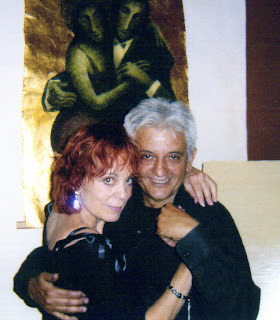 Painting by Jan Rae
Painting by Jan RaeLook what came out early this month! Dear Fund Your Life Overseas Reader,
Cherie was having a tough time. She had just won the fight of her life against cancer, only for her husband to pass away.But this plucky American wouldn’t be beat.Today, she has a new life—and an exciting new overseas career to boot. Greg Lucre
Editor in Chief, Fund Your Life Overseas * * *L.A. Librarian Trades in Books for Tango Shoes
By Cherie MagnusI’ve always loved to dance. I studied ballet as a child. I’ve directed my own belly-dance troupe. In 1997, I finally discovered tango—and I was hooked.When I dance, I feel most like myself. And these days I get to do it all the time as a dance teacher in Buenos Aires, Argentina, passing on one of the most beautiful dances of all—the tango—in the place where it was born and is still at its best.But it took a long time to get here. Over a decade ago, before I left the U.S., things were tough. At 55, after treatments for two bouts of advanced breast cancer, I had to take early retirement from my job as a librarian. At the same time, my husband died, and I was caring for my mother with Alzheimer’s. Then the building where I lived was sold, which meant my rent tripled. That was the last straw…I had always liked Buenos Aires, having visited many times on vacation to dance, and I knew that, since the economic crisis in 2001, it had become a lot more affordable. So in 2003, I packed my bags and made the move with my cat to the Argentine capital.I was excited about living in the mecca of tango. In Buenos Aires, you can dance almost 24/7.I was enjoying life in the city, renting a place in the Caballito neighborhood and studying the Argentine style of Spanish. I attended Toastmasters and Pilates, and I volunteered with the homeless at the Anglican Cathedral downtown.Then one day at a milonga (tango social dances) I saw Rubén Aybar dancing. I could see that he expressed the music the way I felt it. When Rubén finally asked me to dance with him, we clicked perfectly. I had never wanted a dance partner before, as I enjoyed dancing with different men. But Rubén is so creative, musical, and original in his improvisation, I soon became bored dancing with anyone else. We entered the Buenos Aires Tango Championships in 2006 and finished 13th out of more than 500 couples. I was the only foreigner to make it past the semi-finals. After that people asked us to teach.We started with occasional private students in our home studio or in rented studios with larger groups. Then we broadened our services to include accompanying people to milongas to introduce new dancers to the culture and environment.A lot of visitors come and go from Buenos Aires without ever seeing the true social tango that has been danced here for 150 years—they only see tango shows for tourists.And teaching has allowed me to stay in Buenos Aires despite inflation. I rent an apartment in the quiet barrio of Boedo. I’ve also just written a book, The Church of Tango: a Memoir, published by Mirasol Press. Rubén and I plan to continue sharing "our" tango with our students for as long as we are able.
Published on May 20, 2012 19:07
May 17, 2012
A City in Postcards
One of the things I am anxious to do is to get rid of the boxes of possessions I couldn't bear to part with when I left Los Angeles in 2001. I used to collect postcards of old L.A., especially the places/buildings which no longer exist. I've got over 250 of them, along with some postcard books.
I took some photos and here are a few examples:
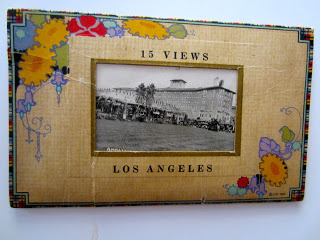 15 black and white real photos from 1926
15 black and white real photos from 1926
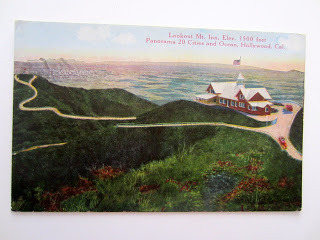 Lookout Mt. Inn--Mulholland
Lookout Mt. Inn--Mulholland
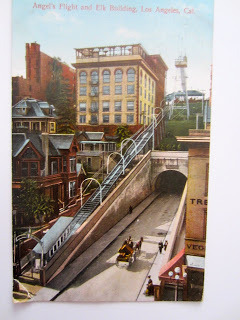 Angel's Flight and the Elks Building
Angel's Flight and the Elks Building
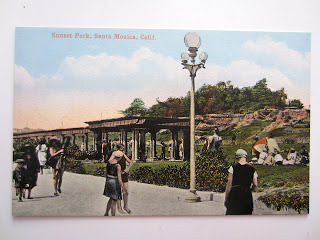 Sunset Park, Santa Monica
Sunset Park, Santa Monica
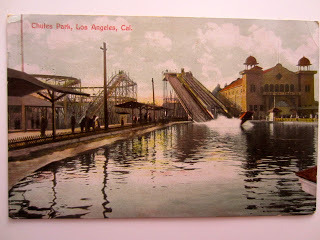 Chutes Park--where was this incredible place?
Chutes Park--where was this incredible place?
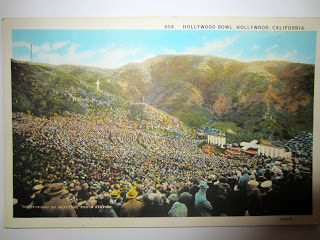 The Hollywood Bowl on Easter--long before the shell
The Hollywood Bowl on Easter--long before the shell
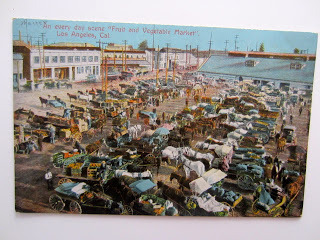 The beginning of my favorite L.A. place--Farmer's Market
The beginning of my favorite L.A. place--Farmer's Market
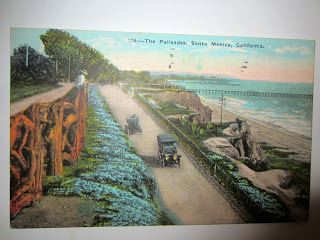 The Palisades incline to PCH, 1928
The Palisades incline to PCH, 1928
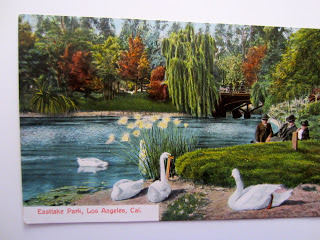 Eastlake Park with swans!!My favorite:
Eastlake Park with swans!!My favorite:
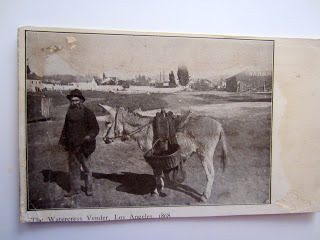 Caption reads: "The watercress seller," Los Angeles, 1868
Caption reads: "The watercress seller," Los Angeles, 1868

I took some photos and here are a few examples:
 15 black and white real photos from 1926
15 black and white real photos from 1926 Lookout Mt. Inn--Mulholland
Lookout Mt. Inn--Mulholland Angel's Flight and the Elks Building
Angel's Flight and the Elks Building Sunset Park, Santa Monica
Sunset Park, Santa Monica Chutes Park--where was this incredible place?
Chutes Park--where was this incredible place? The Hollywood Bowl on Easter--long before the shell
The Hollywood Bowl on Easter--long before the shell  The beginning of my favorite L.A. place--Farmer's Market
The beginning of my favorite L.A. place--Farmer's Market The Palisades incline to PCH, 1928
The Palisades incline to PCH, 1928 Eastlake Park with swans!!My favorite:
Eastlake Park with swans!!My favorite: Caption reads: "The watercress seller," Los Angeles, 1868
Caption reads: "The watercress seller," Los Angeles, 1868
Published on May 17, 2012 17:08
May 14, 2012
Book Reading and Signing in Los Angeles
Published on May 14, 2012 18:14
May 12, 2012
Mother's Day in Los Angeles
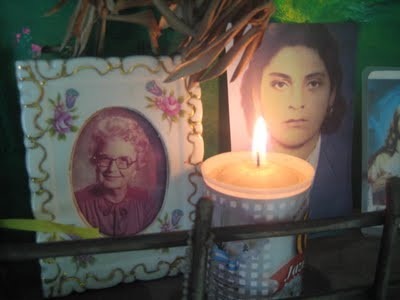
Ruben and I miss our mothers every day.
But at least this year I am with my family in Los Angeles. Flowers, perfume, a night at a club where a friend is the musical director. Not bad to be a mom sometimes! Happy Day to all the moms out there and to all who have or have had mothers. (That's everyone!) Where would we be without them?
Published on May 12, 2012 21:01




